
Journal of Water Resources & Environmental Engineering - No. 87 (12/2023)
56
Asymptotical almost periodicity of solutions to
the Keller-Segel system on real hyperbolic manifolds
Nguyen Thi Van
1
Abstract: In this article, we shall study the Keller-Segel
system on a real hyperbolic space which is one
class of Riemannian manifolds with Ricci curvature
-1
. We prove the existence, uniqueness of
asymptotically almost periodic solutions for the linear equations by using dispersive and sm
oothing
properties of the heat semigroup.
Keywords: Keller-Segel system, smoothing estimates, a
symptotical almost periodicity of solutions,
well-posedness.
1. Introduction
The Keller–Segel model on the real hyperbolic space is decribed as
(1.1)
in which is the Laplace-Beltrami
operator, is the density
of cells, is the
concentration of the chemoattractant,
c
is the
positive sensitivity parameter,
g ³ 0
and
a > 0
represent the decay and production rate of the
chemoattractant, respectively,
h(t)
is
asymptotically almost periodic.
*
The original model has been described
chemotaxis in biological phenomena
(aggregation of organisms sensitive to a
gradient of a chemical substance) by Keller and
Segel (see [Keller et al. 1970]). Due to
significant applications in biology, various
versions of the model have recently been
extensively studied. In the Euclidean space ,
when
n=2
some crucial results are obtained by
several mathematicians (see [Blanchet et al.
2006, Corrias et al. 2014, Dolbeault et al. 2004])
1
Department of Mathematics, Thuyloi University,
Vietnam
Received 31
st
Oct. 2023
Accepted 12
th
Dec. 2023
Available online 31
st
Dec. 2023
and when
n³3
, a large series of results are
from the deep work of Chen, Ferreira (see
[Chen 2018, Ferreira 2021]). Furthermore, on
the hyperbolic manifold , Pierfelice and
Maheux have recently showed the well-
posedness results under the sub-critical
condition in [Pierfelice 2020]. Xuan continued
to prove the existence and uniqueness of
periodic mild solutions to the Keller-Segel
system on both the Euclidean space
(Ricci curvature
-1
), and the hyperbolic space
(see [Xuan et al. 2023]).
It is worth pointing out that the concept of
almost periodicity was firstly introduced by
Bohr in the mid-twenties (see [Bohr 1925]).
Afterwards, the theory of almost periodic
functions was continuously getting built in other
works (for example, [Amerio 1971, Besicovitch
1954, Bochner 1962]). The concept of
asymptotical almost periodicity was introduced
by the French mathematician Fréchet. There are
a number of works of known authors
contributed to asymptotically almost periodic
solutions to differential equations, see [Diagana

Journal of Water Resources & Environmental Engineering - No. 87 (12/2023)
57
2013] for details. In recent work [Xuan et al
2023], the authors used dispersive estimates of
vectorial heat equations and Massera-type
principle to investigate the existence,
uniqueness and exponentially stable behavior of
such solutions to Navier-Stokes equations in
L
p
(H
n
)
spaces for
1<p
. In this paper, we shall
study the asymptotically almost periodic
solutions for the above Keller-Segel system.
This paper is organized in three sections. In
the next section, we give some preliminaries
about asymptotically almost periodic solutions
to (1.1) on the real hyperbolic space . In the
last section, we deal with the existence and
uniqueness of almost periodicity and asymptotic
almost periodicity to the linear system
corresponding to (1.1).
2. Preliminaries
2.1. Functional spaces
Let
,
, where
X
is a Banach space
with the norm
.
Definition 2.1.1. A function is
said to be almost periodic if for each ,
there exists such that every interval of
length contains at least a number
T
with the
following property
We denote as the collection of all
almost periodic functions . Then
is a Banach space endowed with the
norm
, . Obviously, is a
Banach space with the norm
.
Definition 2.1.2. A function is
said to be asymptotically almost periodic if
there exist and
such that .
Set as the collection of all
asymptotically almost periodic functions
. Therefore, is a
Banach space with the norm
.
2.2. The real hyperbolic manifolds
Let be
the real hyperbolic spaces for
n³2
, and a metric
dg = -dx
0
2
+dx
1
2
+...+dx
n
2
.
It implies that
is Riemannian manifolds. In geodesic
polar coordinates, can be written as
and
dg =dt
2
+(sinht)
2
dw
2
,
in which
d
w
2
is the
canonical metric on the sphere . The Laplace-
Beltrami operator on can be expressed as
2.3. The Keller-Segel system on real
hyperbolic manifolds
In view of (1.1), we suppose that
c = 1
and
h(t)= Ñ
x
×f(t,×)
. The second equation of (1.1)
implies to
v= a(-D + gI)
-1
u
. Thus, the Keller-
Segel system on is rewritten by
(2.3.1)
Let
L
j
= ¶
j
(-D + gI)
-1
. We give the
properties of
L
j
in the next lemma (see
[Ferreira 2021, Lemma 4.1]):
Lemma 2.3.1. Let
g ³ 0
,
n³2
,
1<p<n
,
1£d£ ¥
and
1
q=1
p-1
n
. The operator
L
j
is
continuous from to , for each

Journal of Water Resources & Environmental Engineering - No. 87 (12/2023)
58
j=1,2...n
. Moreover, there exists a constant
C>0
independent of
f
and
g
satisfying
L
j
f
L
q,d
£Cg(g)f
L
p,d
,
where
g(0)
=
1
and
g(g)= g
-(n-1)
if
g > 0
.
Moreover, we will utilize
L
p
-L
q
estimates
of the heat semigroup on non-compact
manifolds by Pierfelice (see [Pierfelice 2017,
Theorem 4.1 and Corollary 4.3]).
Lemma 2.3.2.
(i) For
t>0
, and
p
,
q
such that
1£p£q£ ¥
, the following dispersive estimate
holds
for all , where and
d
n
is
a positive constant depending only on
n
.
(ii) For
t>0
, and
p,q
such that
1£p£q£ ¥
, the following estimate holds
for all vector field . The functions
h
n
(t)
and
gp,q
are defined as in Assertion (i).
Next, we will establish the well-posedness of
asymptotically almost periodic solutions to the
linearized equation corresponding to (2.3.1) on the
n-dimensional hyperbolic space for
n³2
.
3. The existence of asymptotically almost
periodic solution to the linearized keller-segel
equation
In this section, we concentrate on studying
the inhomogeneous linearized equation as
follows
(3.1)
for given scalar functions
w
and
f
.
By Duhamel’s principle, the Cauchy problem (1.1) can be formally converted to the integral
equation
(3.2)
The function
u t,x
( )
satisfying (3.2) are
called mild solution for (3.1) (see [Ferreira
2021]). The existence and uniqueness of the
bounded mild solutions of the Cauchy problem
(3.1) is shown in the next lemma.
Lemma 3.1. Let
n³2
,
n<p<2n
. For
given functions and
, there exists a unique mild
solution of Equation (3.1) satisfying
, (3.3)

Journal of Water Resources & Environmental Engineering - No. 87 (12/2023)
59
for a constant independent of
u
0
,u,w,f
.
Proof.
By Lemma 2.3.2 and the boundedness of
L
j
= ¶
j
(-D + gI)
-1
, we obtain
,
in which
G
is Gamma function,
b = g
p/2, p/2
+ g
pn/(4 n-p),p/2
2
,
ˆ
b = g
p/2,p/2
+ g
p/3, p/2
2
, and
It implies that the mild solution exists. The uniqueness of the solution is easy to verify from the
definition (3.2), the common given functions
w
,
f
and the intial condition.
Remark 3.2. If we consider
(3.4)
on the whole line-axis , then mild solutions can be written as [Kozono 1996]:

Journal of Water Resources & Environmental Engineering - No. 87 (12/2023)
60
(3.5)
It can be shown with the same approach as in the proof of Lemma 3.1, Equation (3.4) has a
unique mild solution satisfying
(3.6)
Setting and . Due to Lemma 3.1, the solution operator can be defined as
where
X´Y
is the Cartesian product space equipped with the norm
×
X´Y
= ×
X
+ ×
Y
and
(3.7)
The norm of is treated from the above norm. Next, we will concern the main
theorem of this paper.
Theorem 3.3. Let
n³2
,
n<p<2n
. Suppose that functions
f
and
w
are given such that the
function belongs to . Then, the Cauchy problem (3.1) has a
unique mild solution satisfying
(3.8)
where is given in Lemma 3.1.
Proof. By Lemma 3.1, we will prove that the solution operator
S
maps into
. Let us assume that . Hence, there exist
and such that
f(t)
=
H(t)
+ F
(t)
and
w
(t)
= h
(t)
+ q
(t)
for all . Starting from (3.6), we get
for all .
Let , , and



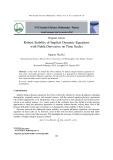

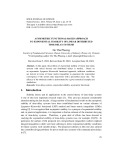
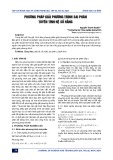
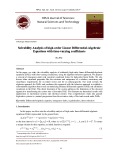
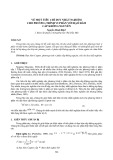
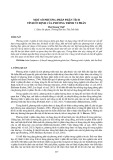










![Bộ câu hỏi lý thuyết Vật lý đại cương 2 [chuẩn nhất/mới nhất]](https://cdn.tailieu.vn/images/document/thumbnail/2025/20251003/kimphuong1001/135x160/74511759476041.jpg)
![Bài giảng Vật lý đại cương Chương 4 Học viện Kỹ thuật mật mã [Chuẩn SEO]](https://cdn.tailieu.vn/images/document/thumbnail/2025/20250925/kimphuong1001/135x160/46461758790667.jpg)




